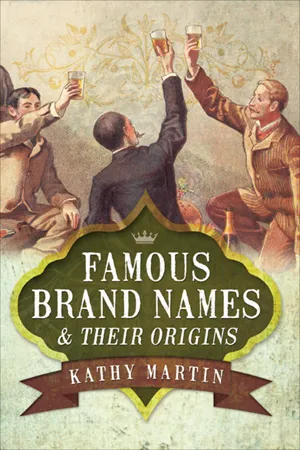![]()
Part I
Food & Drink
![]()
Chapter 1
The Pantry
Prior to the invention of the refrigerator, perishable food items such as butter, cheese, milk, eggs and meat were stored inside small rooms or large cupboards known as pantries and larders. Located either inside the kitchen or adjacent to it, these rooms were usually north-facing to keep them out of the sun. Some had mesh-covered windows which allowed fresh air to circulate whilst keeping flies away. To help them stay cool, the perishable foodstuffs were placed on stone slabs although if space allowed joints of meat would be hung from ceiling hooks.
Did you know …?
The word pantry is derived from ‘pain’, the French word for bread which itself comes from ‘panis’, the Latin word for bread.
Originally, when most people still created their meals from scratch using a few basic ingredients, the walls of the pantry or larder would be lined with shelves containing longer-lasting foodstuffs such as flour, sugar, salt and spices. It wasn’t until the nineteenth century that the first convenience foods became available but thereafter the pantry shelves of a prosperous household groaned with a cornucopia of tempting products, all designed to make life easier for the busy cook.
Canned food had been available in Britain since 1813 but for much of the century it was mainly regarded as a useful tool for the armed forces and intrepid types such as polar explorers. It wasn’t until the early years of the twentieth century that it really caught on with the public, perhaps because until then nobody had thought to invent a decent can opener. After that, however, canned food had arrived in a big way and its place on pantry shelves across the nation was assured.
Did you know …?
Napoleon is indirectly responsible for the invention of canned food. Keen to keep his troops well fed when they were far from home, he offered a reward to anyone able to devise a way of providing nutritious, long-lasting food. A confectioner called Nicholas Appert found that food heated in sealed glass jars would keep for a long time. Another Frenchman, Philippe de Girard, took the idea a step further when he used tinplated cans instead of the highly breakable glass jars. He sold his idea to an English merchant, Peter Durand, who promptly took out a patent to preserve food using the tinplated cans. Durand then sold the patent to an English entrepreneur called Bryan Donkin. In 1813 Donkin set up the first canned food factory, Donkin, Hall and Gamble, in Matlock, Derbyshire.
Thus it can be said that Napoleon is the godfather of canned foods, Appert the grandfather and Girard the father; Donkin, meanwhile, is the ingenious uncle who took the idea by the scruff of its neck and turned it into a viable commercial enterprise.
Ambrosia – dairy delights since 1917
While there may be other brands of tinned rice pudding on our supermarket shelves, to most people the product is synonymous with Ambrosia. The company was founded in 1917 in Lifton, a village located just inside Devon’s border with Cornwall, by a local man called Albert Morris. Initially the Ambrosia creamery turned fresh locally-sourced milk into dried milk suitable for infants and invalids. Dried milk was also supplied to the troops fighting at the Front during the First World War. The milk was delivered daily to the creamery in vast churns and then dried with roller dryers.
Sometime during the 1930s – accounts vary as to precisely when – the creamery started to produce its tinned rice pudding which became an instant hit with the public. Still based in Lifton today, where it provides employment for around 270 people, Ambrosia continues to use milk sourced only from the south-west. In 1990 the company was sold to Colman’s who in turn were acquired by Unilever in 2001. Since 2004, however, Ambrosia has been part of the Premier Foods family.
Did you know …?
During the Second World War tins of Ambrosia Creamed Rice were placed inside Red Cross food parcels.
Baxters – more than a soupçon of quality since 1929
From relatively modest beginnings, Baxters have gone on to win worldwide fame and royal recognition, thanks in no small part to the skill and entrepreneurial flair of successive generations of their womenfolk. The story began in 1868 when 25-year-old George Baxter left a gardening job on the Gordon Castle Estate to open his own grocery shop in the village of Fochabers, located on the east bank of the River Spey, funded by a loan from his family. As a sideline, Baxter’s wife Margaret made jams and jellies which were sold in the shop and found favour with his former employer, the Duke of Richmond and Gordon.
In 1916 the couple’s son, William, built a factory on some land bought from the Duke. Continuing in the tradition of her mother-in-law, William Baxter’s wife, Ethel, created an exceptional range of jams which William marketed throughout Scotland. Then, in 1923, Ethel hired a canning machine and began canning locally-grown fruit such as strawberries, raspberries and plums, in syrup.
In 1929 Ethel took the pivotal step of introducing soups to the Baxters range, utilising the wide range of excellent produce virtually on their doorstep. Products like Baxters Royal Game Soup soon acquired a following with the clientele of leading shops including Harrods and Fortnum & Mason. More flavours were introduced in 1952 when Ena Baxter joined the company; together with her husband Gordon she created a range of traditional Scottish soups that included Scotch Broth and Cock-a-leekie.
In the 1950s Baxter’s were riding high; their soups were exported all over the world and the firm was awarded Royal Warrants by the Queen, the Queen Mother and King Gustav of Sweden. In 1992 another Baxter woman, Gordon Baxter’s daughter Audrey, made her mark on the family business when she took over as Managing Director. She now insists on tasting every new recipe before the product can be approved.
As of 2015 Baxters remains a family business and although soup is now the firm’s flagship product, accounting for about 70 per cent of its sales, it still produces a range of jams and condiments.
Bird’s Custard Powder – under-egging the pud since the 1840s
We Brits have been pouring a sweet sauce made from Bird’s Custard Powder on our puddings for over 160 years. Yet to purists, this undeniably toothsome product isn’t custard at all because it doesn’t contain egg and as the food experts know, you can’t have true custard without egg.
Actually, that’s the whole raison d’être behind Bird’s Custard Powder. It was invented sometime in the 1840s by Birmingham chemist Alfred Bird who wanted his egg-allergic wife to be able to enjoy eating custard. Mrs Bird was very partial to the stuff but her digestion suffered when she gave in to her cravings. Her dilemma inspired Alfred to tinker about in his lab until he had come up with an egg-free alternative to custard. Not only did his cornflour-based creation please Mrs Bird, it also found favour with the British public when it went into mass production.
When Alfred died in 1879 his son, another Alfred, took control of the company, introducing new ranges such as blancmange and jelly. In 1922 Bird’s rebranded with the red, yellow and blue packaging that is still used today. The three-bird logo appeared at the same time. Today Bird’s is part of the Premier Foods group.
Did you know …?
We also have Mrs Bird’s digestive problems to thank for the existence of Baking Powder; before tackling egg-free custard, her husband sought a solution to her yeast intolerance. He came up with Bird’s Fermenting Powder which was later renamed Baking Powder.
Bisto – aboard the gravy train since 1908
‘Ah! Bisto’. Roast dinner enthusiasts have been trotting out the famous gravy powder’s catchphrase for more than ninety years while the product itself dates back to 1908. That was when Messrs Roberts and Patterson, employees of the Cerebos salt company, formulated a recipe for an easy-to-use gravy powder. According to legend, it was at their wives’ request that they came up with the recipe; apparently the ladies were unable to make satisfactory gravy so they turned to their husbands for help.
Whether or not the story is apocryphal, an unfair slur on the culinary prowess of Mrs Roberts and Mrs Patterson, what is undeniable is that the resulting product made it much easier to create lump-free, flavoursome gravy. For that reason it rapidly found favour with the British public and in 1919 the brand’s popularity received a further boost when the Bisto Kids first featured on Bisto’s advertising and packaging.
Illustrator Will Owen created the pair of scruffy street urchins who sniffed the air appreciatively as they caught the appealing aroma of Bisto gravy, prompting them to utter the memorable ‘Ah! Bisto’ catchphrase. The hungry duo’s rather wistful enthusiasm for Bisto resonated with the public to such an extent that they achieved cult-like status, especially during the Twenties and Thirties. The Bisto Kids remained a fixture on Bisto ads until 1996 when they were quietly dropped as part of the brand’s efforts to appear more contemporary. However, the ‘Ah! Bisto’ slogan survives to this day.
The arrival of Bisto Granules in 1979 took gravy-making to a new level of simplicity; now, if you can boil a kettle you can make palatable gravy to accompany your sausage and mash. Today the brand is owned by Premier Foods.
Did you know …?
The Bisto name is an acronym of the phrase ‘Browns Instantly, Seasons and Thickens in One’.
Bovril – beefing up Britain since 1886
The meat extract known as Bovril was created by a teetotal butcher from Edinburgh called John Lawson Johnston; he was born John Johnston but added the Lawson on his marriage to Elizabeth Lawson in 1871. Having studied chemistry for a while at Edinburgh University, Johnston conducted experiments in food preservation in his spare time and this pastime ultimately led to the development of a product which he named Johnston’s Fluid Beef.
His big break came in 1874 when he was commissioned by the French government to look into the potential benefits of concentrated beef products. At the time the French were still smarting from the catastrophic pummelling their troops had taken in the Franco-Prussian War and they thought that improved nutrition might lead to a stronger army. Taking his family to Canada, Johnston opened a factory and began producing his Fluid Beef. The timing was serendipitous because a new Canadian law restricting the sale of alcohol had left the populace searching for a hearty, non-alcoholic substitute. Johnston returned to Britain in 1884, opening a factory in London for the manufacture of his unique product which was renamed Bovril in 1886. The name came from ‘Bos’, the Latin word for ox, and ‘Vril’, a word meaning energy force which was taken from The Coming Race, an 1870 novel by Edward Bulwer-Lytton.
In 1893 Bovril began a sustained advertising campaign aimed at promoting the product’s health benefits (Will Owen, the illustrator who created the Bisto Kids, produced many ads for the Bovril campaign). Its beneficial effect on Britain’s armed forces was emphasised in advertising slogans used during both the Boer War and First World War, and it received glowing testimonials from such patriotic luminaries as Robert Baden-Powell and Rudyard Kipling.
Johnston sold Bovril t...



